The Best Espresso Beans: Beginners Manual to Top Coffee Beans for Espresso: In the world of coffee connoisseurs, the quest for the perfect espresso is a journey that combines artistry, science, and an appreciation for the finest coffee beans. As unfolds, the landscape of espresso beans continues to evolve, presenting enthusiasts with a plethora of choices that can be both exciting and overwhelming. This beginner’s manual delves into the art and science of choosing the perfect espresso beans.
Whether you prefer a single-origin delight or a carefully crafted blend, understanding these factors will empower you to make an informed choice tailored to your unique taste preferences. As we journey through the top espresso beans, we’ll highlight emerging trends, innovative processing methods, and the stories behind each featured coffee.
So, whether you’re on a mission to upgrade your home brewing experience or seeking the perfect beans to impress your customers professionally, join us on this exploration of the best espresso beans in 2023. Your espresso adventure begins here as we uncover the beans that promise to elevate your coffee ritual to new heights.
We will discover the key factors that define exceptional espresso, such as bean origin, roast profile, and blend composition.
The Best Espresso Beans – Reviews and Rank:
Our First Recommendation For The “The Best Espresso Beans” is:
Koffee Kult Dark Roast (Best Overall)
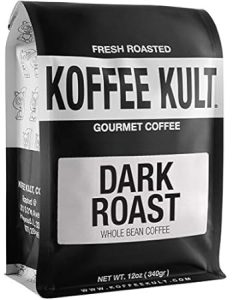
Introduction:
For coffee enthusiasts who appreciate a dark roast’s rich, bold allure, the Koffee Kult Dark Roast Whole Bean Coffee stands as a pinnacle of flavor and craftsmanship. Crafted in small batches with meticulous care, this artisan blend is a testament to the artistry of coffee roasting.
In this exploration, we’ll delve into the depths of this gourmet delight, providing insights into its unique characteristics and what sets it apart in dark roast coffee.
Product Description:
The Koffee Roast Whole Bean Coffee, presented in a 12oz package, is a distinguished blend of 100% Arabica coffee beans. This small-batch gourmet coffee is designed to captivate your senses with its aromatic intensity and robust flavor profile. The dark roast infuses the beans with a deep, smoky essence, creating a bold and smooth brew.
Specialty:
Its commitment to quality throughout the coffee journey sets this dark roast apart. From the organic sourcing of the beans to the small-batch roasting process, Koffee Kult prioritizes the artisanal craft of coffee. The result is a specialty blend catering to those who crave a full-bodied, well-balanced cup of coffee.
Pros:
- Robust Flavor Profile: The dark roast creates intense flavors, offering a satisfyingly bold coffee experience.
- Organically Sourced: Made from 100% Arabica beans sourced organically, ensuring a pure and high-quality product.
- Small-Batch Roasting: The small-batch approach allows precise control over the roasting process, contributing to the coffee’s unique character.
- Aromatic Delight: The blend is known for its captivating aroma, adding an extra layer to the coffee-drinking experience.
Cons:
- Intensity may not be suitable for everyone: The boldness of a dark roast might be too robust for those who prefer milder coffee varieties.
Conclusion:
In the world of dark roast coffees, the Koffee Kult Roast Whole Bean Coffee is a testament to the art of coffee roasting. With its organic sourcing, small-batch craftsmanship, and a flavor profile that satisfies the most discerning palates, this blend is a treat for coffee lovers seeking a rich and aromatic experience.
If you’re on a quest for a dark roast that transcends the ordinary, the Koffee Kult Dark Roast promises a journey into the heart of gourmet coffee culture.
Our Second Recommendation For The “The Best Espresso Beans is:
Kicking Horse Coffee, Cliff Hanger Espresso (Best for Beginners)
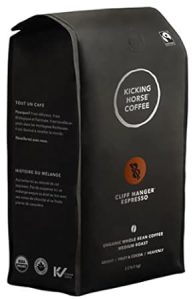
Introduction:
Embark on a flavor journey with the Kicking Horse Coffee, Cliff Hanger Espresso, a medium roast whole bean coffee that beckons coffee enthusiasts to experience the perfect balance of taste and ethics. Sourced from certified organic and fairtrade beans, this 2.2-pound bag of aromatic delight promises a brewing experience beyond the ordinary.
In this exploration, we’ll dive into the details of this medium roast gem, uncovering what makes it a standout choice for those who appreciate coffee’s artistry and the commitment to sustainable practices.
Product Description:
The Kicking Horse Coffee Cliff Hanger Espresso boasts a medium roast that strikes a harmonious balance between a dark roast’s boldness and a light roast’s brightness. In this 2.2-pound bag, the whole beans deliver a flavorful punch, promising a rich and satisfying cup of coffee.
Certified organic and fair trade, this blend reflects Kicking Horse’s dedication to quality, sustainability, and ethical sourcing, ensuring that every sip positively impacts taste buds and the environment.
Specialty:
This espresso’s commitment to organic and fair trade principles sets it apart. The medium roast profile caters to a wide range of coffee preferences, making it an excellent choice for those who enjoy a well-rounded and versatile cup.
The careful selection of beans and the commitment to ethical practices make this blend not just a coffee choice but a conscious lifestyle decision.
Pros:
- Certified Organic: Using organic beans ensures a clean and pure coffee experience.
- Fairtrade Sourcing: Supporting Fairtrade practices promotes ethical treatment of coffee farmers and their communities.
- Medium Roast Balance: The medium roast profile offers a nuanced flavor profile, combining dark roasts’ richness with light roasts’ brightness.
- Whole Bean Freshness: The whole beans preserve freshness, allowing you to grind them just before brewing for a more flavorful cup.
Cons:
- Price Point: A specialty and ethically sourced product, it may be priced higher than some conventional options.
Conclusion:
For those seeking a coffee experience that transcends mere taste, the Kicking Horse Coffee Cliff Hanger Espresso delivers a harmonious blend of flavor, ethics, and craftsmanship. With a commitment to organic and fairtrade principles, this medium roast whole bean coffee is not just a beverage choice but a statement of conscious consumption.
If you want to elevate your coffee ritual with a blend that cares for your palate and the planet, the Cliff Hanger Espresso from Kicking Horse Coffee is a journey worth taking.
Our Third Recommendation For The “The Best Espresso Beans” is:
Lavazza Super Crema (Best Beans for Crema)
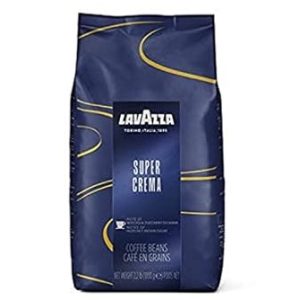
Introduction:
Indulge in the luxurious world of Italian espresso with Lavazza Super Crema Whole Bean Coffee Blend, a masterpiece that captures the essence of a mild and creamy medium espresso roast. This exceptional blend, packaged in a convenient value pack of 6, promises a delightful journey through hazelnut and brown sugar notes.
In this exploration, we’ll unravel the rich tapestry of flavors that Lavazza has crafted, providing a detailed look at what makes this whole-bean coffee a staple in the repertoire of coffee enthusiasts worldwide.
Product Description:
Lavazza Super Crema Whole Bean Coffee Blend celebrates the art of espresso, showcasing a mild and creamy medium roast synonymous with the best Italian coffee culture. This pack of 6, weighing 2.2 pounds each, ensures a consistent supply of high-quality coffee beans.
The flavor profile is a harmonious blend of mildness and richness, with distinct hazelnut and brown sugar notes, creating a well-balanced and satisfying cup of espresso.
Specialty:
The specialty of Lavazza Super Crema lies in its ability to deliver a consistently smooth and creamy espresso experience. The careful selection of beans, coupled with the medium roast profile, strikes a balance that caters to a broad range of coffee preferences. It’s a versatile blend that works well for both standalone espresso shots and as a base for your favorite espresso-based beverages.
Pros:
- Mild and Creamy: The medium roast profile ensures a smooth and creamy texture with a nuanced flavor.
- Value Pack: The pack of 6 offers great value for those who prefer buying in bulk.
- Hazelnut and Brown Sugar Notes: The distinctive flavor notes add a layer of difficulty to the espresso, enhancing the overall drinking experience.
- Versatile Usage: Suitable for various making methods, including espresso machines, drip coffeemakers, and French presses.
Cons:
- Packaging Size: While the value pack is advantageous for frequent coffee drinkers, it may be too large for occasional consumers.
Conclusion:
Lavazza Super Crema Whole Bean Coffee Blend invites you to savor the quintessential Italian espresso experience. With its mild and creamy medium roast, complemented by delightful notes of hazelnut and brown sugar, this blend encapsulates the expertise of Lavazza in the art of coffee roasting.
Whether you’re a seasoned espresso fan or a casual coffee enthusiast, the Super Crema blend is a testament to Lavazza’s commitment to delivering exceptional coffee moments. Elevate your coffee ritual with this value pack, and let the aroma of Italian craftsmanship fill your cup.
Our Fourth Recommendation For The “The Best Espresso Beans” is:
Union Coffee Revelation Espresso (Best Roast to Order Beans)
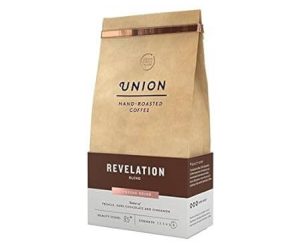
Introduction:
Dive into a world of exquisite flavor with Union Coffee’s Revelation Espresso Grind Blend – a true revelation for coffee lovers seeking a perfect balance of richness and depth in every cup. Available in a convenient pack of 4, each containing 200g of finely ground coffee, this blend is crafted for espresso enthusiasts who appreciate the artistry of a well-brewed shot.
This exploration will uncover the unique qualities that make Union Coffee’s Revelation Espresso a standout choice in finely ground coffee.
Product Description:
The Union Coffee Revelation Espresso Grind Blend is a finely tuned symphony of flavors meticulously crafted to create an exceptional espresso experience. In this pack of 4, each 200g portion ensures freshness and consistency in every grind.
The blend is a testament to Union Coffee’s commitment to quality, featuring a carefully selected combination of beans that promises a rich and nuanced flavor profile.
Specialty:
The specialty of the Revelation Espresso Grind Blend lies in its finely ground texture, tailored specifically for espresso brewing. The grind size is optimized to extract the full spectrum of flavors, resulting in a shot that embodies the perfect balance of acidity, sweetness, and body. This blend is designed for espresso lovers who seek a consistently exceptional cup with each pull.
Pros:
- Finely Ground for Espresso: The finely ground texture is tailored for espresso machines, ensuring a precise and flavorful extraction.
- Pack of 4: Convenient packaging allows for freshness preservation and ease of use, especially for frequent espresso drinkers.
- Rich and Nuanced Flavor Profile: The blend promises a well-balanced combination of flavors, catering to various tastes.
- Union Coffee Quality: Union Coffee is known for its commitment to ethically sourced, high-quality beans.
Cons:
- Limited Versatility: The finely ground nature of the coffee may limit its use to espresso machines, excluding other brewing methods.
Conclusion:
Union Coffee’s Revelation Espresso Grind Blend is a harmonious marriage of craftsmanship and flavor precision. With its finely ground texture and carefully selected beans, this blend is engineered to elevate your espresso experience.
The convenience of a pack of 4 ensures a continuous supply of freshness, making it an excellent choice for dedicated espresso enthusiasts. If you’re searching for a finely crafted espresso blend that consistently delivers on taste and quality, Union Coffee’s Revelation Espresso Grind Blend is a revelation worth savoring.
Our Fifth Recommendation for the “The Best Espresso Beans” is:
100% Hawaiian Kona Roasted Coffee (Eco Friendly)
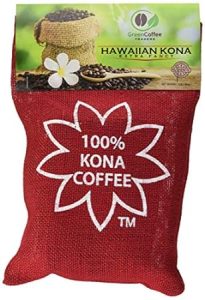
Introduction:
Embark on a journey to the lush coffee plantations of Hawaii with the 1LB. 100% Hawaiian Kona Roasted Coffee Beans. This exceptional coffee blend, sourced exclusively from the Kona region, is a testament to the unparalleled flavors that emerge from Hawaii’s volcanic soil and favorable climate.
In this exploration, we’ll unravel the unique qualities that define these roasted coffee beans, offering you a taste of the islands in every sip.
Product Description:
The 1LB. 100% Hawaiian Kona Roasted Coffee Beans celebrate the world-renowned Kona coffee, known for its exceptional quality and distinctive taste. Harvested from the slopes of Mauna Loa, these beans are roasted to perfection, unveiling the full spectrum of flavors unique to the Kona region.
With a commitment to preserving the purity of the Kona coffee experience, this 1-pound bag delivers the essence of Hawaiian coffee culture to your cup.
Specialty:
The specialty of these coffee beans lies in their origin — the renowned Kona region of Hawaii. The combination of volcanic soil, high elevation, and a tropical climate imparts a unique character to the beans. This specific terroir contributes to the coffee’s smooth body, bright acidity, and delightful notes that can include hints of nuttiness and chocolate.
Pros:
- 100% Hawaiian Kona Coffee: Ensures an authentic and high-quality coffee experience.
- Roasted to Perfection: The beans are expertly roasted to bring out the distinct flavors of Kona coffee.
- Unique Flavor Profile: Offers a combination of smoothness, brightness, and nuanced flavor notes.
- Ideal for Coffee Connoisseurs: Perfect for those who appreciate the subtleties and complexities of premium coffee.
Cons:
- Higher Price Point: Reflective of the exclusivity and quality of Hawaiian Kona coffee, it may be relatively more expensive than other coffee options.
Conclusion:
In the 1LB. 100% Hawaiian Kona Roasted Coffee Beans, you’re not just getting a bag of coffee but immersing yourself in the essence of the Hawaiian coffee heritage. From the volcanic slopes of Mauna Loa to your cup, these beans offer a distinctive and authentic taste that’s truly one of a kind.
While the price may reflect the exclusivity of this Hawaiian gem, the experience of sipping on a cup brewed from these beans is an indulgence that coffee connoisseurs and enthusiasts alike will appreciate. Elevate your coffee ritual with the unique flavors of Hawaiian Kona, and let each sip transport you to the sun-kissed slopes of this tropical paradise.
Our Sixth Recommendation for the “The Best Espresso Beans” is:
Starbucks Dark Roast (Caramel Espresso Option)
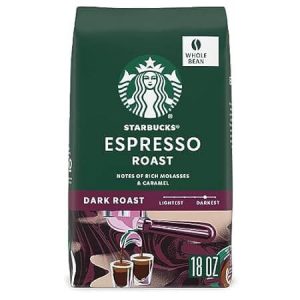
Introduction:
For coffee enthusiasts who savor the bold and intense notes of a well-crafted dark roast, Starbucks Dark Roast Whole Bean Coffee in the Espresso blend stands as a beacon of rich flavor and aromatic delight.
This 100% Arabica blend, encapsulated in a 1-bag package weighing 18 oz, promises a deeply satisfying espresso experience synonymous with the quality and expertise that defines the Starbucks brand. Join us as we explore the characteristics that make this dark roast a staple for those who appreciate the robustness of a finely brewed espresso.
Product Description:
Starbucks Dark Roast Whole Bean Coffee in the Espresso blend is a testament to the art of roasting that has become synonymous with the Starbucks name. This 100% Arabica blend is carefully selected and roasted to perfection, delivering a deep, full-bodied flavor profile ideal for espresso enthusiasts.
The 18 oz bag of whole beans ensures freshness and allows you to grind the coffee just before brewing, preserving the robustness and complexity of the dark roast.
Specialty:
The specialty of this Espresso blend lies in its dedication to crafting a dark roast that brings out the bold and intense flavors espresso aficionados prefer. The Arabica beans in this blend contribute to a smooth and well-balanced cup. At the same time, the dark roast imparts a rich, caramelized sweetness and a hint of smokiness, creating a genuinely indulgent espresso experience.
Pros:
- Expertly Roasted: Starbucks’s expertise in roasting ensures a consistent and high-quality dark roast.
- Versatile Usage: Suitable for various brewing methods, including espresso machines, French presses, and drip coffee makers.
- Full-Bodied Flavor: The dark roast profile delivers a robust and intense flavor experience.
- Trusted Brand: Starbucks is a globally recognized brand known for its commitment to quality coffee.
Cons:
- Price: As a premium brand, Starbucks products can be priced higher than other options.
Conclusion:
Starbucks Dark Roast Whole Bean Coffee in the Espresso blend invites you to experience the bold and captivating world of dark roast espresso. The dedication to quality and flavor excellence shines through from the first whiff of the beans to the last sip of your brewed cup.
Whether you’re a loyal Starbucks enthusiast or an espresso lover seeking a reliable and robust dark roast, this blend delivers on the promise of a deeply satisfying coffee ritual. Elevate your espresso experience with Starbucks, and let each cup celebrate the artistry of crafting the perfect dark roast.
Buyer’s Guide – How to Pick the Best Espresso Beans
Choosing the perfect espresso beans can be a delightful yet challenging task, as various factors contribute to the flavor profile of your espresso. Here’s a comprehensive buyer’s guide to help you navigate the world of espresso beans:
1. Arabica or Robusta?
Arabica:
- Flavor Profile: Generally considered more nuanced and complex, with a wide range of flavors.
- Acidity: Higher acidity, providing brightness to the cup.
- Caffeine Content: Lower compared to Robusta.
- Ideal For: Those who appreciate a well-balanced, aromatic espresso experience.
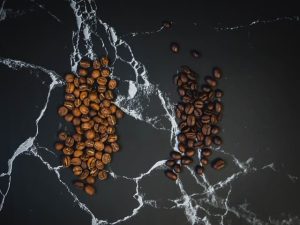
Robusta:
- Flavor Profile: Often more robust and intense, with earthy and nutty notes.
- Acidity: Lower acidity, resulting in a smoother taste.
- Caffeine Content: Higher caffeine levels compared to Arabica.
- Ideal For: Those who prefer a strong, bold espresso flavor with a thicker crema.
2. Dark Roast or Medium Dark Roast?
Dark Roast:
- Flavor Profile: Rich, bold, and often accompanied by smoky or chocolate notes.
- Oiliness: Dark roasts tend to be oilier on the surface.
- Ideal For: Espresso lovers who enjoy a powerful and intense coffee flavor.
Medium Dark Roast:
- Flavor Profile: A balance between dark roasts’ richness and lighter roasts’ brightness.
- Oiliness: Moderate oiliness compared to dark roasts.
- Ideal For: Those seeking a versatile option with a well-rounded flavor profile.
3. Selective Harvested or Strip Harvested?
Selective Harvested:
- Quality: Higher quality, as only ripe cherries are picked.
- Flavor Profile: More nuanced and complex.
- Ideal For: Those who prioritize flavor complexity and are willing to pay a premium for high-quality beans.
Strip Harvested:
- Efficiency: Harvesting all cherries at once is more efficient.
- Flavor Profile: Can have a wider range of flavors but may lack the complexity of selectively harvested beans.
- Ideal For: Budget-conscious buyers who still want a decent flavor profile.
4. Single Origin or Coffee Blends?
Single Origin:
- Distinctiveness: Showcases the unique flavors of beans from a specific region or farm.
- Consistency: Flavors can vary with each harvest.
- Ideal For: Those who enjoy exploring the nuanced flavors of different coffee-growing regions.
Coffee Blends:
- Balanced Flavors: Blends are crafted for consistency, offering a balanced flavor profile.
- Versatility: Roasters can tailor blends to achieve specific taste profiles.
- Ideal For: Espresso enthusiasts seeking a reliable and consistent flavor experience.
5. Whole Bean or Ground Coffee?
Whole Bean:
- Freshness: Maintains freshness longer as the beans are protected from oxidation.
- Customization: You can grind the beans to your preferred consistency before brewing.
- Ideal For: Those who prioritize freshness and enjoy the hands-on grinding process.
Ground Coffee:
- Convenience: Ready to use, saving time on grinding.
- Flavor: Ground coffee may lose some flavor nuances more quickly.
- Ideal For: Those who value convenience and may not have access to a grinder.
6. Coffee Maker
The choice of coffee maker can significantly impact the extraction and overall flavor of your espresso:
Espresso Machine:
- Precision: Ensures precise temperature and pressure for extracting espresso.
- Ideal For: Espresso purists who want to enjoy the true essence of the beans.
French Press:
- Full Extraction: Produces a full-bodied cup with a rich flavor profile.
- Ideal For: Those who enjoy a robust and textured coffee experience.
Pour-Over:
- Clarity of Flavor: Allows for a clean and nuanced extraction.
- Ideal For: Those who appreciate the clarity of individual flavor notes.
Drip Coffee Maker:
- Convenience: Provides a hassle-free brewing process.
- Ideal For: Those who prefer a straightforward preparing method with less involvement.
In conclusion, the best espresso beans for you depend on your individual preferences and brewing methods. Experimenting with different options will help you discover the perfect mixture that suits your taste and coffee ritual.
Whether you prefer the complexity of single-origin Arabica beans or the robustness of a dark roast Robusta blend, the world of espresso beans offers diverse options to explore.
Conclusion:
As we wrap up our journey through the best espresso beans, it becomes evident that the world of coffee is as diverse and dynamic as ever. From the rich, volcanic slopes of Hawaii to the bustling coffee farms of Ethiopia, each bag of espresso beans tells a story, a narrative woven through careful cultivation, selective harvesting, and expert roasting processes.
In our exploration, we’ve encountered the bold and robust notes of dark roasts, the nuanced and intricate flavors of single-origin beans, and the harmonious blends carefully crafted by passionate roasters. The choice between Arabica and Robusta, dark or medium dark roast, selective or strip harvesting, single origin or blends—each decision contributes to the unique work of tastes that dance on your palate with every sip.
In beyond, the quest for the perfect espresso continues, fueled by the passion of coffee enthusiasts worldwide and the dedication of roasters committed to delivering excellence in every bean. Here’s to the joy of exploration, the richness of flavor, and the enduring love affair with the espresso elixir. Cheers to a year filled with exceptional coffee moments and the promise of new blends and flavors waiting to be discovered.
FAQs:
What is Espresso Coffee?
Espresso coffee, often called “espresso,” is a concentrated beverage prepared by forcing hot water through finely ground coffee under high pressure. It is known for its solid and robust flavor and its rich, creamy layer on top called “crema.” Here are key characteristics and aspects of espresso:
- Brewing Process:
- Espresso is brewed using an espresso machine, which forces hot water through a compacted puck of finely ground coffee at high pressure.
- The high pressure typically ranges from 9 to 10 atmospheres (bars) and helps extract the flavors and oils from the coffee quickly.
- Coffee Beans:
- Espresso can be made from various coffee beans, but Arabica and Robusta are the two most common varieties.
- Arabica beans are often favored for their nuanced tastes, while Robusta beans are known for their higher caffeine content and thicker crema.
- Brewing Time:
- Espresso is brewed quickly, usually in 25 to 30 seconds. The short brewing time is a critical factor in creating its concentrated flavor.
- Crema:
- Crema is the golden-brown, frothy layer that forms on top of a well-brewed shot of espresso. It is a mixture of coffee oils and carbon dioxide produced during brewing.
- Flavor Profile:
- Espresso is known for its intense and complex flavor profile, often described as bold, intense, and full-bodied.
- The taste can vary based on the type of coffee bean, roast level, and blend used.
- Serving Size:
- A standard single shot of espresso is about 1 ounce (30 milliliters), and a double shot is around 2 ounces (60 milliliters).
- Espresso is the base for other coffee beverages, including lattes, cappuccinos, and Americanos.
- Cultural Significance:
- Espresso holds cultural significance in many regions, particularly Italy, where it originated. In Italian coffee culture, enjoying a quick shot of espresso at a café is a social and daily ritual.
What is the difference between an Espresso Bean and a Standard Coffee Bean?
The terms “espresso bean” and “standard coffee bean” can be a bit misleading, as they often refer to the same type of coffee bean. The key difference between coffee beans used for espresso and those used for other brewing methods lies more in factors like roast level, grind size, and blend composition rather than the intrinsic nature of the bean itself. Here’s a breakdown of the distinctions:
- Type of Coffee Bean:
- Espresso and standard coffee can be made from Arabica, Robusta beans, or a blend. The choice of bean type contributes to the flavor profile but is not exclusive to either brewing method.
- Roast Level:
- Espresso beans are often associated with a darker roast. The prolonged roasting process brings out intense flavors and can contribute to the development of oils on the bean’s surface.
- Standard coffee beans can be roasted to various levels, including light, medium, and dark. Lighter roasts may preserve more of the bean’s origin flavors, while darker roasts tend to have a bolder and more robust taste.
- Grind Size:
- Espresso beans are ground to a fine consistency, resembling powdered sugar. The fine grind is crucial for the quick extraction process in an espresso machine.
- Standard coffee beans can be ground to various sizes depending on the brewing method. For example, a coarse grind is suitable for a French press, while a medium grind is common for drip coffee makers.
- Blend Composition:
- Espresso blends are often crafted with a specific balance of beans to achieve a particular flavor profile. Blends may include a combination of beans from different regions and with different characteristics.
- Standard coffee blends can also be crafted for specific flavor profiles, but the composition may vary based on the desired taste for the brewing method.
- Brewing Method:
- Espresso is brewed using an espresso machine, which forces hot water through the finely ground coffee at high pressure.
- Standard coffee can be brewed using various methods, such as drip, pour-over, French press, etc.
- Flavor Profile:
- Espresso is known for its intense, concentrated flavor and rich crema. The flavor is often bold full-bodied, and can include a range of nuances depending on the beans used.
- Standard coffee has a more varied flavor profile based on the roast level, bean origin, and brewing method. Depending on preferences, it can be light and fruity or dark and robust.
In summary, while the term “espresso bean” is commonly used to describe beans used for espresso, the type of bean itself is not different from those used for standard coffee. The key distinctions lie in the roast level, grind size, blend composition, and brewing method. Coffee enthusiasts can choose beans based on their personal preferences, whether they prefer espresso’s concentrated intensity or standard coffee’s varied flavors.
What is Cold Brew Espresso?
“Cold brew espresso” is a term that combines two popular coffee trends: cold brew and espresso. However, it’s essential to note that traditionally, espresso is a concentrated coffee beverage brewed with hot water under pressure. In contrast, cold brew is made by steeping tastelessly ground coffee beans in cold water for an extended period. The two methods have different extraction processes and flavor profiles.
Some coffee shops and enthusiasts may use the term “cold brew espresso” to describe a cold brew concentrate combined with water, milk, or other ingredients to create a drink reminiscent of cold brew and espresso characteristics. Here are the key components:
- Cold Brew Concentrate:
- Cold brew espresso starts with a concentrated cold brew coffee. This concentrate is made by steeping coarsely ground coffee beans in cold water for an lengthy period, usually 12 to 24 hours.
- Dilution:
- To create the final cold brew espresso drink, the concentrated cold brew is often diluted with water, milk, or a milk alternative to achieve the desired strength and flavor.
- Serving Style:
- Cold brew espresso can be served over ice, similar to traditional cold brew coffee, or incorporated into specialty coffee drinks.
- Flavor Profile:
- The resulting flavor profile combines cold brew’s smooth, low-acid characteristics and the concentrated, bold flavors reminiscent of espresso. Depending on the coffee beans used, it may have a rich, full-bodied taste with records of chocolate, nuts, or other flavors.
It’s essential to recognize that this term might not adhere to strict coffee terminology, as authentic espresso is brewed under pressure with hot water. However, the evolving world of coffee is characterized by creativity and experimentation, and the term “cold brew espresso” reflects the desire to blend the unique qualities of both cold brew and espresso into a refreshing and flavorful beverage.
You might want to explore coffee shops or recipes that specifically offer or create cold brew espresso-style drinks if you’re intrigued.
What is the difference between Espresso and Americano Coffee?
Espresso and Americano are popular coffee drinks, but they differ significantly in preparation, strength, and flavor. Here are the key distinctions between espresso and Americano:
Espresso:
- Brewing Method:
- Espresso is a concentrated coffee drink made by forcing worm water under weight through finely ground coffee. The result is a small, intense shot of coffee.
- Strength:
- Espresso is known for its strong and bold flavor. It has a higher coffee solids, oils, and flavors concentration than regular drip coffee.
- Volume:
- A standard shot of espresso is typically about 1 ounce (30 milliliters).
- Crema:
- Espresso is characterized by crema, a golden-brown layer of frothy oils that forms on top of a well-pulled shot.
- Serving Size:
- It is commonly served in small amounts, either as a single or double shot.
Americano:
- Brewing Method:
- An Americano is made by diluting a shot (or more) of espresso with hot water. It essentially “extends” the espresso shot.
- Strength:
- Americano has a milder flavor than espresso due to the dilution of hot water. It more closely resembles the strength of regular drip coffee.
- Volume:
- The volume of an Americano is more significant than a standard espresso’s. The amount of water added can be adjusted to achieve the desired strength.
- Crema:
- Americanos usually do not have a significant layer of crema, as they are made by adding hot water to the espresso.
- Serving Size:
- An Americano’s serving size is more significant than a standard espresso’s. Depending on personal preference, it can range from 4 to 12 ounces or more.
What is the difference between Espresso and Cappuccino Coffee?
Espresso and cappuccino are popular coffee beverages, but they differ significantly in preparation, composition, and flavor. Here are the key distinctions between espresso and cappuccino:
Espresso:
- Brewing Method:
- Espresso is a concentrated coffee beverage ready by forcing hot water under pressure through excellently ground coffee. It results in a small, intense shot of coffee.
- Strength:
- Espresso has a strong and bold flavor. A higher concentration of coffee solids, oils, and flavors than regular drip coffee characterizes it.
- Volume:
- A standard shot of espresso is typically about 1 ounce (30 milliliters).
- Crema:
- Espresso is known for crema, a golden-brown layer of frothy oils that forms on top of a well-pulled shot.
- Serving Size:
- Espresso is typically served in small amounts, either as a single or double shot.
Cappuccino:
- Composition:
- A cappuccino is a chocolate drink that contains of equal portions of espresso, steamed milk, and frothed milk. It is known for its layered composition.
- Brewing Method:
- Cappuccino starts with a shot (or more) of espresso as its base.
- Milk Texture:
- The steamed milk in a cappuccino has a velvety texture, while the frothed milk adds a creamy, airy layer on top.
- Strength:
- Cappuccino has a balanced flavor due to the combination of espresso and milk. It is milder than a straight shot of espresso.
- Volume:
- The total volume of a cappuccino is more significant than that of a standard espresso, typically ranging from 5 to 6 ounces.
- Presentation:
- A well-prepared cappuccino has a distinct presentation with equal layers of espresso, steamed, and frothed milk.
Can you make Espresso with Medium Roast Beans?
Yes, you can make espresso with medium roast beans. While espresso is traditionally associated with dark roasts, medium roast beans can produce a flavorful and well-balanced shot. Medium roasts preserve more of the bean’s natural characteristics, offering a nuanced taste profile with moderate acidity.
The grind size and extraction time are crucial; use a fine grind to ensure proper extraction to achieve the desired concentration. Experimenting with different medium roast beans allows you to discover unique flavor notes, making it a versatile choice for those who enjoy a milder yet richer espresso experience.
Where do Coffee Beans Come From?
Coffee beans come from the Coffea plant’s seeds, which are native to hot regions of Africa. The primary coffee-producing countries are located in what is known as the “Coffee Belt,” which spans the latitude among the Tropics of Cancer and Capricorn. The major coffee-producing regions include:
- Latin America:
- Countries like Brazil, Colombia, and Mexico significantly contribute to the global coffee supply. Each region within these countries can produce beans with distinct flavor profiles.
- Africa:
- Ethiopia, the birthplace of coffee, is a significant producer. Other African countries like Kenya, Tanzania, and Uganda also play a significant role in the coffee industry. African coffees are known for their bright tartness and fruity flavors.
- Asia:
- Countries such as Vietnam and Indonesia, particularly the island of Sumatra, are important coffee producers. Coffees from this region often have earthy and spicy notes.
- Central America:
- Countries like Costa Rica, Guatemala, and Honduras are known for producing high-quality Arabica beans. These coffees often have a balanced profile with bright acidity.
- Caribbean:
- Some Caribbean nations, like Jamaica, produce sought-after beans. Jamaican Blue Mountain coffee is particularly renowned for its mild flavor and lack of bitterness.
- Yemen:
- Yemen is known for producing unique coffee beans, often called Yemeni or Arabian. Yemeni coffees are distinct for their winey acidity and rich entire body.
The specific characteristics of coffee beans, including flavor, aroma, and acidity, are influenced by altitude, climate, soil, and the particular variety of coffee plants (Arabica or Robusta). Each region contributes to the diverse world of coffee, offering a wide range of flavors and profiles for coffee enthusiasts to explore.

